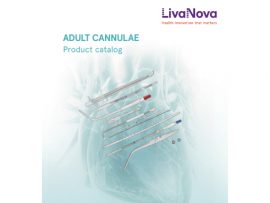Abstract Treating severe lung diseases with extracorporeal membrane oxygenation (ECMO) is often accompanied by serious complications, restricting applicability and adversely affecting outcomes. Membrane oxygenators, based on hollow fiber membranes (HFM),..
Read MoreAbstract Introduction Heparin is usually added to infant cardiopulmonary bypass circuit primes. Ultrafiltration is often used to minimise prime volume before commencing bypass. The extent of heparin removal from bypass..
Read MoreAbstract This study focuses on the impact of virtual reality (VR) technologies on educational processes and professional training, particularly in the fields of medicine, aviation, and the arts. The purpose..
Read MoreAbstract Objectives: An increasing number of pediatric centers use the femoral vein in neonates and smaller children to provide venovenous multisite (VVMS) extracorporeal membrane oxygenation (ECMO), but there are no..
Read MoreAbstract Objectives: Limited data exist on outcomes in COVID-19- vs. influenza A (H1N1)-associated acute respiratory distress syndrome (ARDS) patients when supported on venovenous extracorporeal membrane oxygenation (ECMO). We aimed to..
Read MoreAbstract The optimal arterial cannulation site in minimally invasive cardiac surgery (MICS) remains debated. While axillary, femoral, and central approaches each offer distinct advantages, no prior network meta-analysis has compared..
Read MoreAbstract Invasive cases of Mycobacterium chimaera have been found in Europe, and beyond, and have been associated with the use of heater–cooler units necessary to regulate the temperature of blood in extracorporeal..
Read MoreAbstract Thrombosis and inflammation represent major challenges limiting the functionality of asymmetric poly(4-methyl-1-pentene) (PMP) hollow fiber membranes in extracorporeal membrane oxygenation (ECMO) systems. Moreover, the interplay between these two pathological..
Read MoreAbstract Data on factor XIII (FXIII) activity in patients on extracorporeal membrane oxygenation (ECMO) are scarce. In this prospective, observational, single-centre study, we determined the rate of acquired FXIII deficiency..
Read MoreAbstract Background: Postcardiotomy shock, often necessitates advanced mechanical circulatory support. Veno-arterial extracorporeal membrane oxygenation (VA-ECMO) and the Impella 5.5 device are crucial for hemodynamic stabilization. This study evaluates the efficacy and..
Read MoreAbstract Mechanical circulatory support devices (MCSDs) have revolutionized the management of advanced heart failure and critical cardiopulmonary conditions. These devices, categorized into temporary and long-term systems, provide crucial circulatory and..
Read MoreAbstract Background Extracorporeal cardiopulmonary resuscitation (ECPR) improves survival for patients experiencing refractory cardiac arrest but is often associated with severe ischemia-reperfusion injury (IRI). Hydrogen gas (H2) has demonstrated promising preclinical..
Read MoreAbstract Critically acute and ill and Obstetrical patients constitute a unique clinical population with a high mortality rate. Extracorporeal membrane oxygenation (ECMO) is gradually being used in obstetrical acute and..
Read MoreAbstract Computational fluid dynamics (CFD) assessments in blood pumps (BPs) typically rely on constant boundary conditions, despite the dynamic nature of the cardiovascular system. Consensus on CFD methodologies for simulating..
Read MoreAbstract Delayed sternal closure (DSC) is a technique used in complex cardiac surgery (CCS) and is associated with an increased risk of surgical site infection (SSI). SSI increases hospital stay..
Read MoreAbstract Objective This scoping review aimed to examine current literature on the use of point-of-care ultrasound (POCUS) in paediatric patients supported by extracorporeal membrane oxygenation (ECMO). It assessed existing evidence,..
Read MoreAbstract This retrospective cohort study evaluates the validity of the Renal Angina Index (RAI) in predicting acute kidney injury (AKI) in 272 patients receiving extracorporeal membrane oxygenation (ECMO) support. The..
Read MoreAbstract Peristaltic pumps are commonly used in medical applications like cardiopulmonary bypass and drug infusion due to their minimal contact with bio-fluids and precise flow control. However, these pumps generate..
Read MoreAbstract Objectives Although CO₂ insufflation play an established role in open-heart surgery, its optimal application in minimally invasive cardiac procedures remains unclear. This study systematically compared continuous versus single CO₂..
Read MoreAbstract Objective Patients on venoarterial extracorporeal membrane oxygenation undergoing ipsilateral cannulation may develop distal limb ischemia. We postulate 2 clinical questions: (1) Would contralateral cannulation have a lower distal limb..
Read MoreAbstract Objective To compare mortality and organ injury associated with intraoperative hyperoxia and normoxia in cardiac surgery patients. Design Systematic review and meta-analysis of randomized clinical trials (RCTs). Setting Tertiary..
Read MoreAbstract Cannulae with multi-staged side holes (SHs) for venous drainage are widely used for performing extracorporeal circulation. Various types of catheters are used worldwide; however, data on the flow performance..
Read MoreAbstract Background Outcomes of postcardiotomy extracorporeal membrane oxygenation (ECMO) are well studied, but preoperative ECMO bridging is less studied. This single-center review evaluates outcomes of patients supported with ECMO as..
Read MoreAbstract Background: Infants with congenital heart disease (CHD) frequently undergo surgery during their first year of life. Infants undergoing CHD surgery experience systemic inflammation and haemodilution that can deplete circulating..
Read MoreAbstract Background: End-stage heart failure remains a major global health challenge with high mortality. While heart transplantation is the gold-standard treatment, the scarcity of donor hearts necessitates alternative therapies. Left..
Read MoreAbstract Purpose Fibrinogen is widely used in cardiac surgery. Still, reported associations between plasma fibrinogen level and chest tube drainage are weak. The results of trials on fibrinogen supplementation are..
Read MoreAbstract Background Neuroprotection during aortic arch surgery often involves hypothermia and the use of adjunctive cerebral perfusion. While antegrade cerebral perfusion (ACP) is favored for extended hypothermic circulatory arrest (HCA),..
Read MoreAbstract To our knowledge, no previous reports have described the use of veno-venous extracorporeal membrane oxygenation (V-V ECMO) in patients wearing a halo vest. We present a case in which..
Read MoreAbstract Background Immediate initiation of extracorporeal membrane oxygenation (ECMO) has not demonstrated benefit in individuals diagnosed with cardiogenic shock based on the presence of hypotension. The relationship between other hemodynamic..
Read MoreAbstract INTRODUCTION: Patent ductus arteriosus in adults is rare, and is commonly recommended to be closed due to the possibility of cardiac complications. Patent ductus arteriosus closure has been often performed..
Read More



















